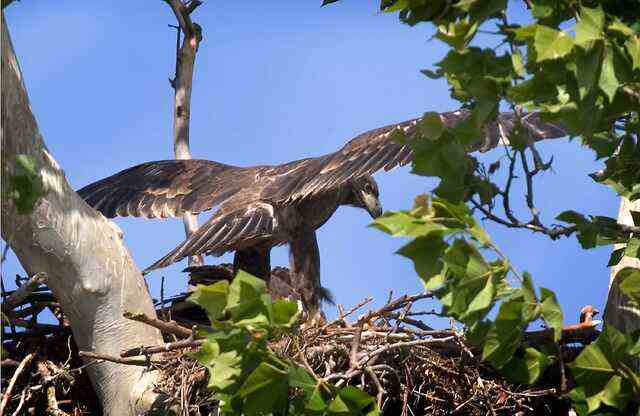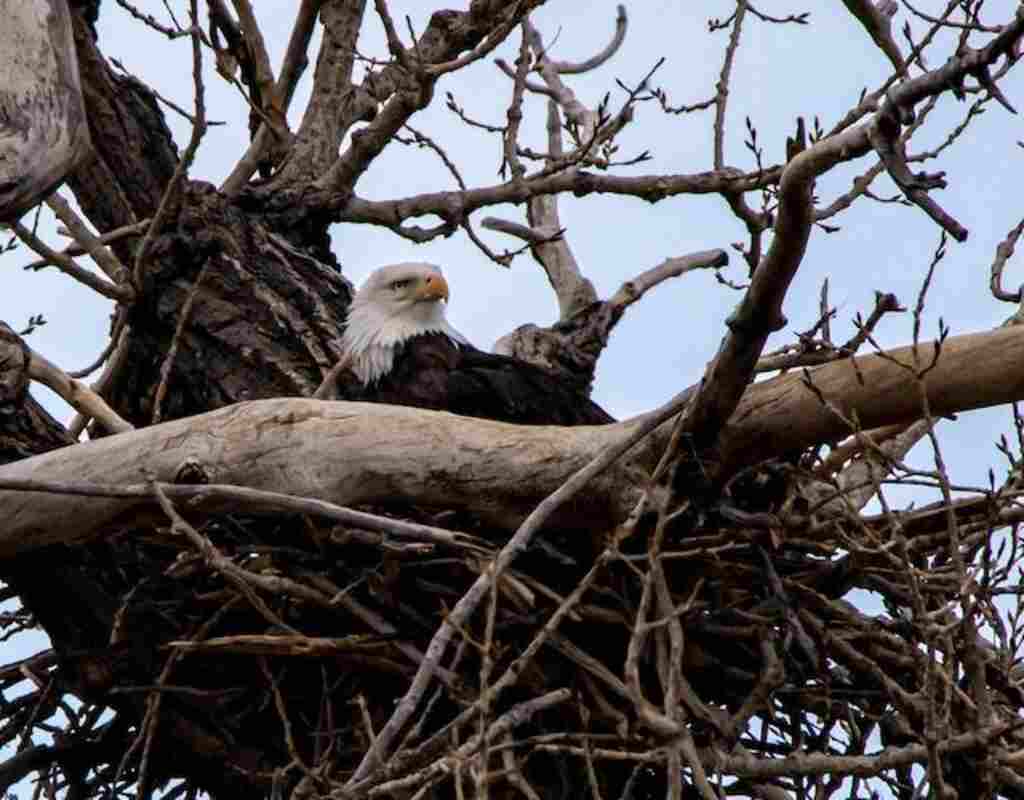Amidst Alabama’s wilderness, the majestic eagle soars, symbolizing power and freedom. Nature’s guardian, these regal birds play a crucial role in the state’s ecosystem. Delving into eagle mating, we explore the timing, courtship, and nesting intricacies.
Factors like weather and breeding season patterns shape their mating habits. Through scientific research, we reveal the significance of specific mating sites. Understanding eagle mating allows us to appreciate their connection with the landscape.
Join us on this journey to uncover the mysteries of when eagles mate in Alabama and gain insight into nature’s rhythms.
Table of Contents
- 1 Key Takeaways
- 2 When Do Eagles Mate In Alabama
- 3 The Life Cycle of Eagles
- 4 Weather Conditions and Breeding Season in Alabama
- 5 Factors Affecting Eagle Mating in Alabama
- 6 Courtship Rituals and Displays
- 7 Nesting Patterns and Behavior
- 8 Conservation Efforts for Eagles in Alabama
- 9 Threats to Eagle Mating in Alabama
- 10 Important Eagle Mating Sites in Alabama
- 11 The Significance of Eagle Mating in Alabama’s Ecosystem
- 12 Observing Eagle Mating in Alabama
- 13 Conclusion and Future Outlook for Eagle Mating in Alabama
- 14 FAQs: When Do Eagles Mate In Alabama?
- 14.1 What is the average lifespan of an eagle in Alabama?
- 14.2 How many eggs does an eagle typically lay during mating season?
- 14.3 Are there any specific predators that pose a threat to eagle mating in Alabama?
- 14.4 How far do eagles typically travel during their courtship rituals and displays?
- 14.5 What are the key factors that contribute to successful eagle nesting in Alabama?
- 15 Author
Key Takeaways
- Eagle mating in Alabama is influenced by factors such as weather conditions and breeding season patterns.
- Bald eagles breed in late fall or early winter, while golden eagles breed in late winter or early spring.
- Eagles prefer temperatures between 30 and 60 degrees Fahrenheit during the breeding season.
- Adequate rainfall is necessary for prey availability and breeding success.
When Do Eagles Mate In Alabama
Eagles typically mate in Alabama from late October to early January, with nesting activity starting one to three months before the female lays eggs. However, the exact timing can vary depending on the location and weather conditions.
Eagles tend to mate for life, and if one partner dies, the other quickly finds a new mate if one is available. If you’re interested in viewing eagles during mating season, it’s important to observe them from a safe distance to avoid disturbing their natural behavior.
The Life Cycle of Eagles
The life cycle of eagles encompasses various stages, including mating, which occurs during a specific time in Alabama. Eagle courtship behaviors play a crucial role in the mating process.
These behaviors involve aerial displays, where the male and female eagles engage in intricate flight patterns, swooping, and diving.
These displays help to establish pair bonds and ensure genetic compatibility. The breeding season of eagles in Alabama can vary depending on the species.
For example, the bald eagle breeding season typically begins in late fall or early winter, while the golden eagle breeding season starts in late winter or early spring.
This variation is influenced by factors such as food availability, migration patterns, and weather conditions.
Understanding these eagle breeding season variations is essential for conservation efforts and maintaining healthy eagle populations.
Transitioning to the subsequent section about weather conditions and breeding season in Alabama, it is important to consider how these factors impact the timing and success of eagle mating.
Weather Conditions and Breeding Season in Alabama
During the breeding season in Alabama, the atmospheric conditions and climate play a crucial role in providing the ideal environment for the courtship and reproductive activities of these majestic avian creatures.
The weather impact on eagle mating behavior is significant, as eagles rely on specific weather conditions to successfully mate and raise their young.
- Temperature: Eagles prefer moderate temperatures during the breeding season, typically between 30 and 60 degrees Fahrenheit. This temperature range ensures the survival of eggs and chicks.
- Precipitation: Adequate rainfall is necessary for the availability of prey, which directly affects the breeding success of eagles.
- Wind: Strong winds can disrupt courtship displays and make it challenging for eagles to build and maintain their nests.
The interaction between these weather factors influences the timing and success of eagle mating in Alabama. These weather conditions, along with other factors, will be discussed in the subsequent section about factors affecting eagle mating in Alabama.
Factors Affecting Eagle Mating in Alabama
Factors influencing the successful reproduction of eagles in Alabama are determined by a complex interplay of various environmental and ecological elements.
The breeding season in Alabama typically occurs from late December to early March, but the specific timing of eagle mating can be influenced by several factors.
One key factor is the availability of suitable nesting sites, such as tall trees near bodies of water.
Eagles also require an abundant food supply, primarily fish, during the breeding season to ensure successful reproduction.
Additionally, favorable weather conditions, including mild temperatures and reduced precipitation, can contribute to successful eagle mating by providing optimal conditions for hunting and nesting.
Understanding these factors is crucial for conservation efforts and ensuring the long-term viability of eagle populations in Alabama.
Transitioning to the subsequent section about ‘courtship rituals and displays’, these factors lay the groundwork for the intricate behaviors exhibited during the mating process.
Courtship Rituals and Displays
Courtship rituals and displays play a significant role in the intricate mating behaviors exhibited by eagles in Alabama. These behaviors are essential for pair formation and strengthening the bond between mates.
Courtship displays are elaborate and involve a series of aerial acrobatics, such as soaring, diving, and cartwheeling, accompanied by vocalizations.
Mating rituals include mutual preening, where the male and female groom each other’s feathers, and the exchange of food gifts.
These displays and rituals serve multiple purposes, including attracting a mate, establishing territory boundaries, and determining the suitability of potential partners.
Observing these courtship behaviors is a thrilling experience, as it showcases the eagles’ agility, strength, and commitment to reproduction.
Understanding courtship displays and mating rituals provides valuable insights into the reproductive strategies of eagles in Alabama.
Moving forward, an exploration of their nesting patterns and behavior will shed light on their next phase of the reproductive cycle.
Nesting Patterns and Behavior
The selection of nesting sites is a critical aspect of eagle behavior. Eagles typically choose large, sturdy trees located near bodies of water for their nests.
The height and location of the nest provide protection from predators and allow for a clear view of the surroundings.
Incubation and parental care are also important behaviors in the nesting patterns of eagles. Both the male and female take turns incubating the eggs, with the male often taking the night shift.
Once the eggs hatch, both parents play an active role in feeding and protecting the chicks until they are ready to fledge.
Selection of Nesting Sites
Nesting preferences of eagles in Alabama are influenced by the availability of tall and sturdy trees, with a study reporting that approximately 80% of eagle nests were found in pine trees.
Eagles exhibit specific nesting behavior to ensure breeding success. They construct large nests, known as eyries, which are built with sticks and lined with softer materials such as moss, feathers, and grass.
These nests are typically located at heights of 20 to 60 feet above the ground.
The choice of nesting site is crucial for the success of the breeding pair, as it provides protection from predators and allows for a clear view of the surroundings.
Eagles also tend to choose nesting sites near bodies of water, as this facilitates easy access to food sources.
Transitioning into the subsequent section about ‘incubation and parental care,’ the selection of an appropriate nesting site is just the first step in the intricate process of raising eagle chicks.
Incubation and Parental Care
Incubation and parental care are critical stages in the life cycle of eagles, during which the dedicated parents diligently guard their precious offspring, ensuring their survival and growth.
The incubation period for eagle eggs typically lasts around 35 days. During this time, the parents take turns sitting on the eggs to keep them warm and protected.
Once the eggs hatch, the parents continue to provide constant care and attention to their young. They engage in intricate feeding behavior, tearing small pieces of prey and feeding it to their chicks.
This process not only ensures that the chicks receive the necessary nutrients for their development but also helps them develop important hunting skills.
As the chicks grow, the parents gradually reduce their feeding and encourage them to start hunting on their own. This transition prepares the young eagles for independence and survival in the wild.
Transitioning from parental care to conservation efforts for eagles in Alabama, initiatives have been implemented to protect and preserve their habitats, ensuring the long-term survival of these majestic birds.
Conservation Efforts for Eagles in Alabama
Conservation efforts for eagles in Alabama have significantly contributed to the protection and preservation of their population.
These efforts focus on understanding and conserving the breeding season of eagles, ensuring their successful reproduction.
Various organizations and agencies, such as the Alabama Wildlife and Freshwater Fisheries Division, work towards habitat protection and management, nest monitoring, and predator control.
Additionally, educational programs and public awareness campaigns have been implemented to engage the community in eagle conservation.
The commitment of these conservation initiatives has resulted in a positive impact on the eagle population in Alabama.
However, despite these efforts, there are still threats to eagle mating in Alabama, which need to be addressed to ensure the continued success of their population.
Threats to Eagle Mating in Alabama
Predation, habitat loss, and disturbance from human activities pose significant challenges to the mating success of the eagle population in Alabama.
These threats to eagle mating in Alabama have a direct impact on the reproductive success and overall population of eagles in the state.
Habitat loss, in particular, has been a major concern as it reduces the availability of suitable nesting sites and foraging areas for eagles.
The destruction and fragmentation of habitats lead to decreased prey availability, making it harder for eagles to find sufficient food during the mating season.
Additionally, human activities such as logging, construction, and recreational activities can disrupt eagle nesting sites and disturb their mating behaviors.
These disturbances can cause eagles to abandon their nests or relocate to less suitable areas, further compromising their mating success.
Hence, the conservation efforts need to focus on addressing these threats and protecting the remaining habitats that are crucial for eagle mating.
Transitioning into the subsequent section about ‘important eagle mating sites in Alabama,’ it is vital to understand the significance of preserving these habitats to ensure the continued reproductive success of the eagle population.
Important Eagle Mating Sites in Alabama
Nesting high atop the towering pines of the Conecuh National Forest, these majestic birds find solace in their secluded love nests, where they engage in intricate courtship rituals that have been passed down through generations.
Alabama is home to several important eagle mating sites, which play a crucial role in the eagle population growth.
These sites provide suitable habitats and resources necessary for successful mating and raising of eagle chicks.
The mating season for eagles in Alabama typically lasts from late fall to early spring, with peak activity occurring in December and January.
During this time, eagles engage in elaborate displays of aerial acrobatics, vocalizations, and nest-building activities to attract mates and establish pair bonds.
These mating sites serve as important breeding grounds, contributing to the overall population growth and genetic diversity of eagles in Alabama.
Transitioning to the next section, the significance of eagle mating in Alabama’s ecosystem becomes evident when considering their role as top predators and their impact on the local food chain.
The Significance of Eagle Mating in Alabama’s Ecosystem
The intricate courtship rituals of eagles in Alabama’s mating sites evoke images of majestic birds engaging in elaborate displays of aerial acrobatics and vocalizations, creating a captivating scene in the secluded love nests high atop the towering pines of the Conecuh National Forest.
These rituals not only serve as a means of attracting a mate but also play a crucial role in the overall ecosystem of Alabama.
The significance of eagle mating in Alabama’s ecosystem lies in its impact on the local wildlife population.
As eagles mate and raise their young, they contribute to the balance of the ecosystem by controlling the population of their prey, such as fish and small mammals.
This helps maintain the health and diversity of the ecosystem, ensuring the survival of various species.
Observing eagle mating in Alabama provides a unique opportunity to witness the intricate dynamics of these majestic birds as they contribute to the delicate web of life.
Observing Eagle Mating in Alabama
Observing eagle mating in Alabama requires careful planning and adherence to proper etiquette and wildlife conservation guidelines.
To maximize the chances of sighting eagles engaged in mating behavior, it is essential to know the best times and locations for viewing.
Additionally, it is crucial to follow proper etiquette such as maintaining a respectful distance and avoiding disturbing the eagles or their habitat.
By adhering to these guidelines, observers can have the opportunity to witness this significant ecological event while minimizing any potential negative impacts on the eagles and their environment.
Best Times and Locations for Viewing
One can witness the majestic courtship displays of eagles in Alabama during specific times and at carefully chosen locations. To have the best chance of viewing these awe-inspiring events, it is important to be aware of the optimal times and best locations.
Here are four key factors to consider:
- Season: The prime time for eagle mating in Alabama is during the winter months, from December to February.
- Time of day: Eagles are most active during the early morning and late afternoon, so plan your visit accordingly.
- Water bodies: Eagles prefer to mate near large bodies of water, such as rivers, lakes, or reservoirs. These areas provide them with an abundant food source.
- Wildlife management areas: Some wildlife management areas in Alabama, such as Lake Guntersville State Park and Wheeler National Wildlife Refuge, offer excellent opportunities for eagle viewing.
By following these guidelines, observers can increase their chances of witnessing eagle mating displays in Alabama. Proper etiquette and wildlife conservation guidelines should also be observed to ensure the well-being of these magnificent creatures.
Proper Etiquette and Wildlife Conservation Guidelines
To ensure the preservation of these magnificent creatures and their natural habitat, adherence to proper etiquette and wildlife conservation guidelines is of utmost importance.
When engaging in wildlife observation and responsible tourism, it is crucial to prioritize the well-being and protection of the eagles and their environment.
This can be achieved by following a set of guidelines that promote respect and minimize disturbance.
For instance, maintaining a safe distance from the nests and avoiding any sudden movements or loud noises can help minimize stress for the eagles.
Additionally, refraining from feeding or touching the eagles is essential to maintain their wild instincts and prevent dependency on humans.
By practicing responsible behavior, visitors can enhance their experience while ensuring the long-term sustainability of eagle populations in Alabama.
Looking ahead, the next section will discuss the conclusion and future outlook for eagle mating in Alabama.
Conclusion and Future Outlook for Eagle Mating in Alabama
In light of the current research, it becomes abundantly clear that the conclusion reached regarding the timing of eagle mating in Alabama lays a solid foundation for future investigations in this field.
Conservation efforts play a crucial role in ensuring the breeding success rates of eagles in Alabama.
By adhering to proper etiquette and wildlife conservation guidelines, humans can minimize disturbances to the eagles’ natural habitat and breeding behaviors.
These efforts involve maintaining a safe distance from nesting areas, refraining from excessive noise and movement, and avoiding direct contact with the eagles.
In doing so, the breeding success rates can be maximized, leading to a healthier eagle population in Alabama.
Future studies should focus on further understanding the specific factors that influence eagle mating behaviors, as well as implementing effective conservation strategies to protect these majestic birds and their habitats.
FAQs: When Do Eagles Mate In Alabama?
What is the average lifespan of an eagle in Alabama?
The average lifespan of an eagle in Alabama is typically around 20-30 years. This information is valuable for understanding the longevity of these birds, but it does not directly address the question regarding eagle mating.
How many eggs does an eagle typically lay during mating season?
During the breeding season, eagles typically lay one to three eggs. This is a common pattern observed in eagle breeding habits, with the number of eagle offspring varying depending on factors such as food availability and reproductive success.
Are there any specific predators that pose a threat to eagle mating in Alabama?
Predator interactions play a crucial role in eagle mating success. In Alabama, potential threats to eagle mating include raccoons and great horned owls. Nesting site selection becomes critical in minimizing predation risk and ensuring reproductive success.
How far do eagles typically travel during their courtship rituals and displays?
Eagle courtship behavior involves elaborate displays and rituals. During this period, eagles typically travel varying distances depending on the species, habitat, and availability of resources. These behaviors aim to establish pair bonds and ensure successful mating.
What are the key factors that contribute to successful eagle nesting in Alabama?
Factors affecting eagle nesting success in Alabama include habitat quality, nest site availability, prey abundance, and human disturbance. High-quality habitats with suitable trees for nesting and an abundant food supply contribute to successful nesting.







